A comparative study of patient and provider priorities for cesarean delivery anesthesia care
IF 2.3
3区 医学
Q2 ANESTHESIOLOGY
引用次数: 0
Abstract
Introduction
Patient priorities for anesthesia during a cesarean delivery are not well defined. Previous studies have explored patient preferences for cesarean delivery anesthesia but have not evaluated patient-centered endpoints unrelated to the physical experience which are known to be important to patients’ birth experiences, such as being treated with respect, communication, and emotional support. The purpose of this study was to compare patients’ and providers’ priorities for cesarean delivery anesthesia care.
Methods
This prospective cross-sectional quantitative survey study included patients with recent cesarean deliveries and clinical providers who provide clinical care for cesarean deliveries. Eleven patient-centered factor related to cesarean delivery anesthesia experience were identified based on previously reported findings and results of semi-structured interviews. Participants then completed a forced ranking survey for these 11 factor, ranked in order from most important to least important aspect of cesarean anesthesia care. They also ranked most desired to least desired anesthesia side effects (e.g., pruritus, nausea, pain). Participants also rated their perceived importance of the factor ranked highest and lowest on a 0–10 numeric rating scale (0 = not important at all and 10 = most important imaginable). Rankings from patient and provider groups were compared using Plackett-Luce method using tree-based recursive partitioning.
Results
One hundred forty-four respondents (127 patients, 17 providers) were included in the analysis. “Physical safety of the baby” was ranked highest among patients and was higher than the rank assigned by providers (P < 0.001). Although mothers with vs. without self-reported birth trauma each highly prioritized safety of baby, the relative priority placed on this factor was higher among mothers with self-reported birth trauma. For anesthesia-related side effects, patients and providers agreed that memory loss, spinal headaches, and pain or discomfort during surgery, represented high-priority concerns to avoid; drowsiness, shivering, and pruritus were considered lower-priority. There were ranking differences between in person and digital recruited patients.
Conclusion
Patients and providers have discordant views on priorities during cesarean delivery, and similar views on priorities for anesthesia-related side effects. A self-reported history of birth trauma, but not pain during cesarean delivery, is associated with high prioritization of physical safety of mother and baby over other cesarean experience priorities. Future clinical care improvements and research are needed to help patients and providers balance the outcomes most important to patients during and after cesarean delivery.
剖宫产麻醉护理中患者和提供者优先级的比较研究
在剖宫产过程中,患者对麻醉的优先级还没有很好的定义。先前的研究探讨了患者对剖宫产麻醉的偏好,但没有评估与身体体验无关的以患者为中心的终点,这些终点已知对患者的分娩体验很重要,例如受到尊重、沟通和情感支持。本研究的目的是比较患者和提供者对剖宫产麻醉护理的优先级。方法本前瞻性横断面定量调查研究纳入近期剖宫产患者和为剖宫产提供临床护理的临床医护人员。根据先前报道的结果和半结构化访谈的结果,确定了与剖宫产麻醉经验相关的11个以患者为中心的因素。然后,参与者完成了对这11个因素的强制排名调查,按照剖宫产麻醉护理中最重要到最不重要的方面进行排名。他们还对最希望出现的麻醉副作用(如瘙痒、恶心、疼痛)进行了排序。参与者还根据0 - 10的数字等级对他们认为的因素的重要性进行了最高和最低的评分(0 = 根本不重要,10 = 最重要)。使用基于树的递归划分的Plackett-Luce方法比较患者和提供者组的排名。结果共纳入144名调查对象(127名患者,17名医疗服务提供者)。“婴儿的身体安全”在患者中排名最高,高于提供者的排名(P <; 0.001)。尽管自我报告分娩创伤的母亲和没有自我报告分娩创伤的母亲都高度重视婴儿的安全,但在自我报告分娩创伤的母亲中,这一因素的相对优先级更高。对于麻醉相关的副作用,患者和医生一致认为,记忆丧失、脊柱头痛和手术过程中的疼痛或不适是需要优先避免的;困倦、颤抖和瘙痒被认为是次要的。真人和数字招募的患者之间存在等级差异。结论患者与医护人员对剖宫产手术的优先顺序有不同的看法,对麻醉相关副作用的优先顺序有相似的看法。自我报告的分娩创伤史,而不是剖宫产过程中的疼痛史,与母亲和婴儿的身体安全高度优先于其他剖宫产经验优先相关。未来的临床护理需要改进和研究,以帮助患者和提供者平衡对剖宫产期间和之后患者最重要的结果。
本文章由计算机程序翻译,如有差异,请以英文原文为准。
求助全文
约1分钟内获得全文
求助全文
来源期刊
CiteScore
4.70
自引率
7.10%
发文量
285
审稿时长
58 days
期刊介绍:
The International Journal of Obstetric Anesthesia is the only journal publishing original articles devoted exclusively to obstetric anesthesia and bringing together all three of its principal components; anesthesia care for operative delivery and the perioperative period, pain relief in labour and care of the critically ill obstetric patient.
• Original research (both clinical and laboratory), short reports and case reports will be considered.
• The journal also publishes invited review articles and debates on topical and controversial subjects in the area of obstetric anesthesia.
• Articles on related topics such as perinatal physiology and pharmacology and all subjects of importance to obstetric anaesthetists/anesthesiologists are also welcome.
The journal is peer-reviewed by international experts. Scholarship is stressed to include the focus on discovery, application of knowledge across fields, and informing the medical community. Through the peer-review process, we hope to attest to the quality of scholarships and guide the Journal to extend and transform knowledge in this important and expanding area.

 求助内容:
求助内容: 应助结果提醒方式:
应助结果提醒方式:


